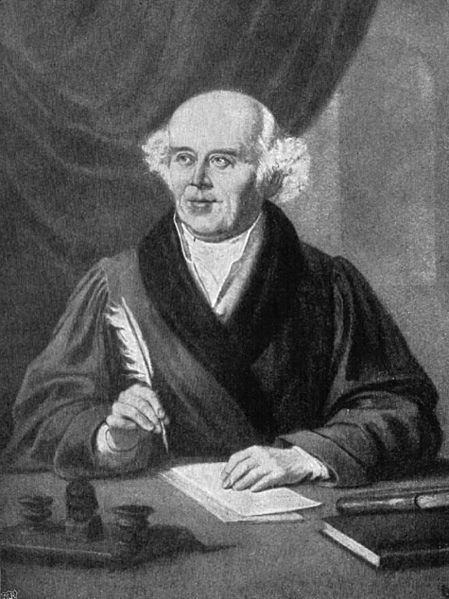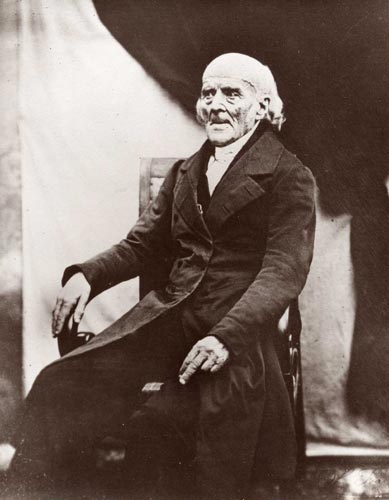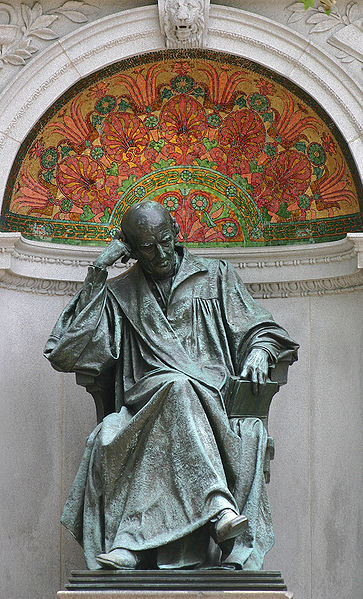<Back to Index>
- Physician Christian Friedrich Samuel Hahnemann, 1755
- Composer Eugen Francis Charles d'Albert, 1864
- U.S. Navy Commodore Matthew Calbraith Perry, 1794



Christian Friedrich Samuel Hahnemann (10 April 1755 – 2 July 1843), a German physician, created an alternative medicine practice called homeopathy.
Christian Friedrich Samuel Hahnemann was born in Meissen, Saxony. His father, along with many other family members, was a painter and designer of porcelain, for which the town of Meissen is famous. As a young man, Hahnemann became proficient in a number of languages, including English, French, Italian, Greek and Latin. He eventually made a living as a translator and teacher of languages, gaining further proficiency in "Arabic, Syriac, Chaldaic and Hebrew".
Hahnemann studied medicine for two years at Leipzig. Citing Leipzig's lack of clinical facilities, he moved to Vienna, where he studied for ten months. After one term of further study, he graduated MD at the University of Erlangen on 10 August 1779, qualifying with honors. His poverty may have forced him to choose Erlangen, as the school's fees were lower. Hahnemann's thesis was titled Conspectus adfectuum spasmodicorum aetiologicus et therapeuticus. [A Dissertation on the Causes and Treatment of Cramps]
In
1781,
Hahnemann
took a village doctor’s position in the copper mining
area of Mansfeld, Saxony. He soon married Johanna
Henriette Kuchler and would eventually have eleven children. After abandoning medical
practice, and while working as a translator of scientific and medical
textbooks, Hahnemann travelled around Saxony for many years, staying in
many different towns and villages for varying lengths of time, never
living far from the River
Elbe and
settling
at different times in Dresden, Torgau, Leipzig and Köthen
(Anhalt) before finally moving to
Paris in June 1835. Hahnemann
claimed
that the medicine of his time did as much harm as good: My
sense of duty would not easily allow me to treat the unknown
pathological state of my suffering brethren with these unknown
medicines. The thought of becoming in this way a murderer or malefactor
towards the life of my fellow human beings was most terrible to me, so
terrible and disturbing that I wholly gave up my practice in the first
years of my married life and occupied myself solely with chemistry and writing. After
giving up his practice around 1784, Hahnemann made his living chiefly
as a writer and translator, while resolving also to investigate the
causes of medicine's alleged errors. While translating William
Cullen's A
Treatise on the Materia Medica,
Hahnemann encountered the claim that cinchona,
the
bark of a Peruvian tree, was effective in treating malaria because of its astringency. Hahnemann
believed that other astringent substances are not effective
against malaria and began to research cinchona's effect on the human
body by self-application. Noting that the drug induced malaria-like
symptoms in himself, he concluded that it would do so in any healthy
individual. This led him to postulate a healing principle: "that which
can produce a set of symptoms in a healthy individual, can treat a sick
individual who is manifesting a similar set of symptoms." This principle, like cures like,
became the basis for an approach to medicine which he gave the name homeopathy.
He
first used the term homeopathy in his essay Indications of the
Homeopathic Employment of Medicines in Ordinary Practice, published in Hufeland's
Journal in 1807. Hahnemann
tested
substances for the effect they produced on a healthy individual
and tried to deduce from this the ills they would heal. From his
research, he initially concluded that ingesting substances to produce
noticeable changes in the body resulted in toxic effects. He then
attempted to mitigate this problem through exploring dilutions of the
compounds he was testing. He claimed that these dilutions, when
prepared according to his technique of succussion (systematic mixing through
vigorous shaking) and potentization,
were
still
effective in alleviating the same symptoms in the sick. Hahnemann
began practicing this new technique, which attracted other doctors
c.1792. He
first
published an article about the homeopathic approach in a German
language medical
journal in 1796. Following a series of further essays, he published in
1810, his The
Organon
of
the Healing Art, the first
systematic treatise and
containing all his detailed instructions on the subject. The Organon is
widely regarded as a remodelled form of an essay he published in 1806
called "The Medicine of Experience," which had been published in
Hufeland's Journal. Of the Organon, Dudgeon states it "was an
amplification and extension of his "Medicine of Experience," worked up
with greater care, and put into a more methodical and aphoristic form,
after the model of the Hippocratic writings."
Around
the
start
of the 19th century Hahnemann developed a theory, propounded
in his 1803 essay On
the Effects of Coffee from Original Observations, that many
diseases are caused by coffee. Hahnemann later abandoned
the coffee theory in favour of the theory that disease is caused by
Psora, but it has been noted that the list of conditions Hahnemann
attributed to coffee was similar to his list of conditions caused by
Psora. The coffee theory has been described as "a good example both of
Hahnemann's superior mental powers and of his occasional tendency to
make up a grand theory from scant evidence". In
early
1811 Hahnemann moved his family
back to Leipzig with the intention of
teaching his new medical system at the University of
Leipzig. In accordance with the university statutes, he became a
faculty member by submitting and defending a thesis on a medical topic
of his choice. On 26 June 1812, Hahnemann presented a Latin thesis, entitled "A Medical Historical
Dissertation on the Helleborism of the Ancients." Hellebore,
a
number
of species of poisonous flowering plants, related to Buttercup and Magnolia. Hahnemann
continued practicing and researching homeopathy, as well as writing and
lecturing for the rest of his life. He died in 1843 in Paris, at 88
years of age, and is entombed in a mausoleum at Paris's Père
Lachaise cemetery. While
there are a few living descendants of Hahnemann’s older sister
Charlotte (1752 – 1812),
there
is only one known living descendant of Hahnemann himself, Mr
Charles Tankard-Hahnemann (7th generation descendant of Dr Samuel
Hahnemann). His
father, Mr William Herbert Tankard-Hahnemann (1922 – 2009), the great,
great, great grandson of Samuel Hahnemann died on 12 January 2009 (his
87th birthday) after 22 years of active patronage of the British
Institute of Homœpathy.
As
a young boy, William remembered his mother telling him of her visits
to her ‘grand-dad Leo’ at Ventnor, Isle of Wight. Later William
Hahnemann knew that this was Dr Leopold Süβ-Hahnemann, Dr Samuel
Hahnemann’s grandson, the only son of his favourite daughter Amelie
(1789 – 1881). Dr Süβ-Hahnemann was the only member of the
Hahnemann
family to be present at Samuel Hahnemann’s funeral, apart from
Hahnemann’s second wife Mélanie, in Paris in 1843 and at his
subsequent re-burial in the Père Lachaise Cemetery in east
Paris, where only persons of truly notable distinction are interred.
Subsequently Leopold emigrated from France to England where he
practised homœopathy in London. He retired to the Isle of Wight and
died there at the outbreak of World War I in 1914. Dr Leopold
Süβ-Hahnemann’s youngest daughter, Amalia had two children,
Winifred (born 1898) and Herbert. Mr William Tankard-Hahnemann was
Winifred’s son. Apart from serving as the patron of the British
Institute of Homœopathy, he also had a distinguished career in the City
of London and was honoured by being appointed as a ‘Freeman of the City
of London’.